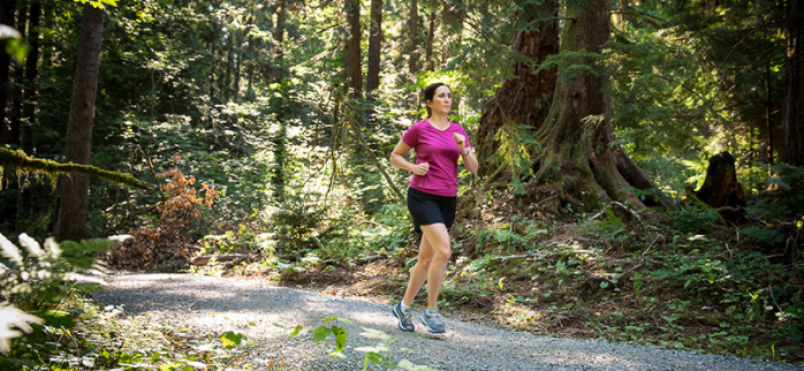If there’s one thing the Greater Vancouver area isn’t lacking, it’s trails. Whether it’s your favourite neighbourhood path or a special trek that’s always worth the drive, there’s no shortage of places to go enjoy the great outdoors.
But did you know if you follow several of the trails running through the Lower Mainland and its coastal forests, you could make it all the way to the East Coast?
Several local paths are actually part of a wider network, comprising The Great Trail (previously known as the Trans Canada Trail).
The impressive trail is 27,000 kilometres long, spanning across 13 provinces and territories. Best of all, it’s been 100 per cent connected since 2017 - making it the longest recreational, multi-use trail in the world.
As it turns out, the trails that comprise these networks are in high demand. This week it was revealed by a national Léger survey that trail use remains a central part of Canadian life, with 75% of Canadians using trails for exercise and leisure time. Of that number, 55% use trails at least monthly, and nearly a third (31%) weekly.
The survey of more than 1,500 Canadians was conducted across Canada.
We might be a little biased, but there’s no questioning that the more than 600-km-long Southwest Region section of the trail is one of the best parts to experience.
While it’s possible to cycle the whole trail, despite its varying terrain, according to Trails BC much of this section is better experienced on foot; in particular Horseshoe Bay to Fort Langley.
For adventurous paddlers, there’s also a Trans Canada Trail water route that travels along the Howe Sound Marine Trail to Squamish, as well as west to Gibsons.
The North Shore
The North Shore’s portion of the trail includes two separate routes, for hikers and cyclists, which traverse 32km and 27km, respectively, from Horseshoe Bay to North Vancouver.
The main route for those travelling on foot follows the Seaview Walk out of Horseshoe Bay - an abandoned BC Rail grade that offers stunning views of Fisherman's Cove and Eagle Island - before moving on to a forested trail that takes hikers into the North Shore Mountains to the Cleveland Dam, Capilano Regional Park, and Mosquito Creek, before arriving at the SeaBus terminal, where trail users looking to continue the route into downtown Vancouver can enjoy a quick cruise.
For cyclists, the route from the Horseshoe Bay Ferry Terminal to the Cleveland Dam mainly follows already existing cycling routes through West Vancouver, using quiet residential streets and sidewalks, before arriving at the Cleveland Dam. From there, cyclists and the walkers follow the same trail as they make their way from Capilano Regional Park to North Vancouver.
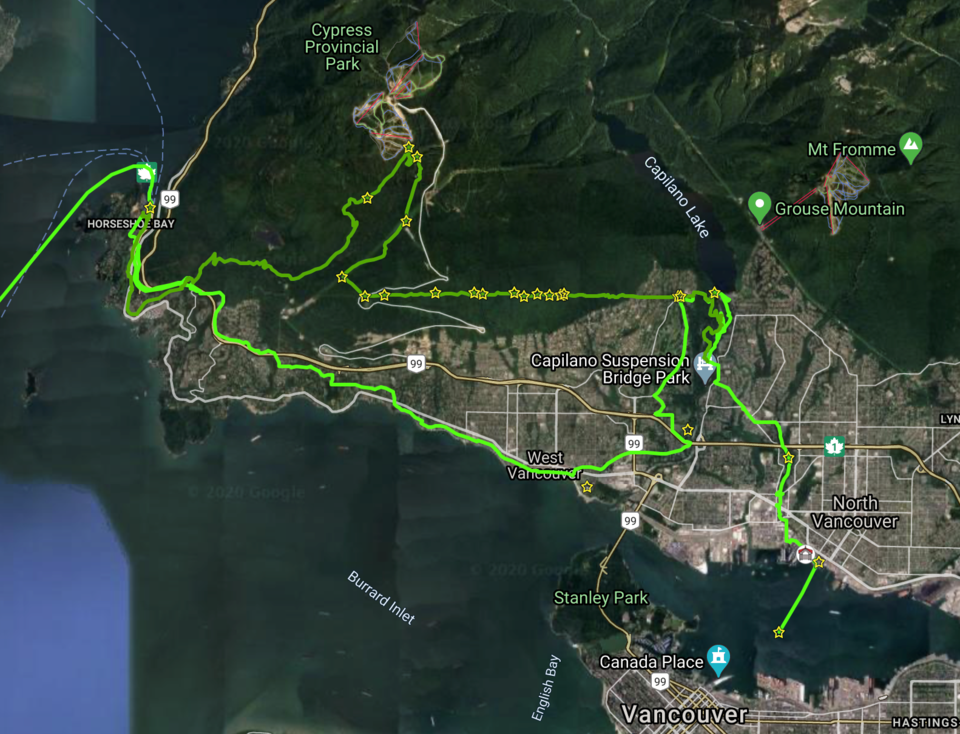 Screenshot / Google Maps via Trails BC
Screenshot / Google Maps via Trails BC
Downtown Vancouver and Burnaby
While the West Coast’s natural wilderness is undoubtedly spectacular, there’s still beauty to be found in cities and more developed areas.
This section of the trail leads travellers to some of Vancouver’s most iconic areas, beaches and landmarks, including Coal Harbour, Stanley Park, Lost Lagoon, English Bay, South False Creek and Granville Island, Chinatown, and New Brighton Park.
Once the trail arrives in Burnaby, users will mostly follow pathways and sidewalks through greenways connecting parks along Burrard Inlet, like Montrose Park - which overlooks former Crabtown - Confederation Park, Capitol Hill Conservation Area, Kensington Park, and Burnaby Mountain Park.
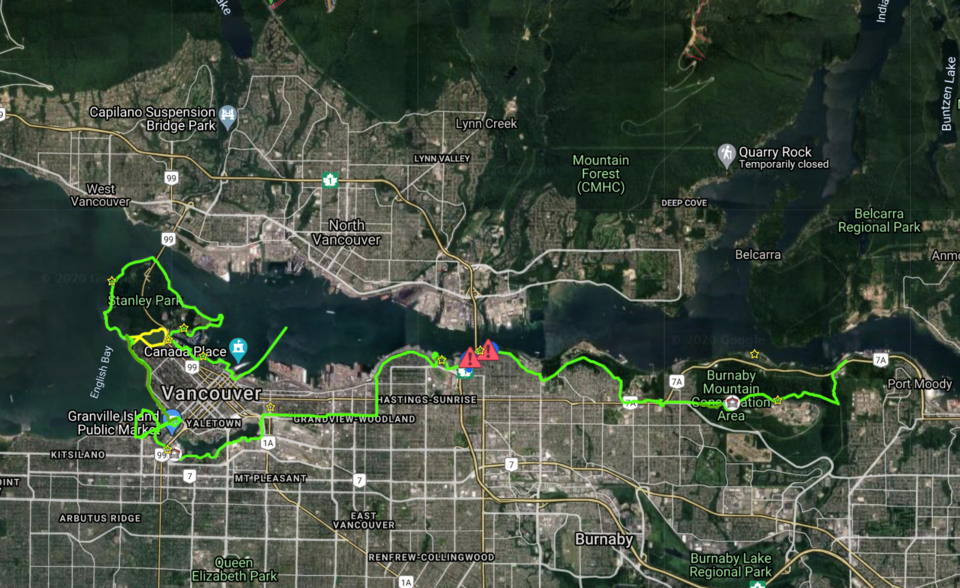 Screenshot / Google Maps via Trails BC
Screenshot / Google Maps via Trails BC
Tri-Cities
According to Trails BC, the Tri-Cities portion of the Great Trail is 26-km long and runs through Port Moody, Coquitlam and Port Coquitlam.
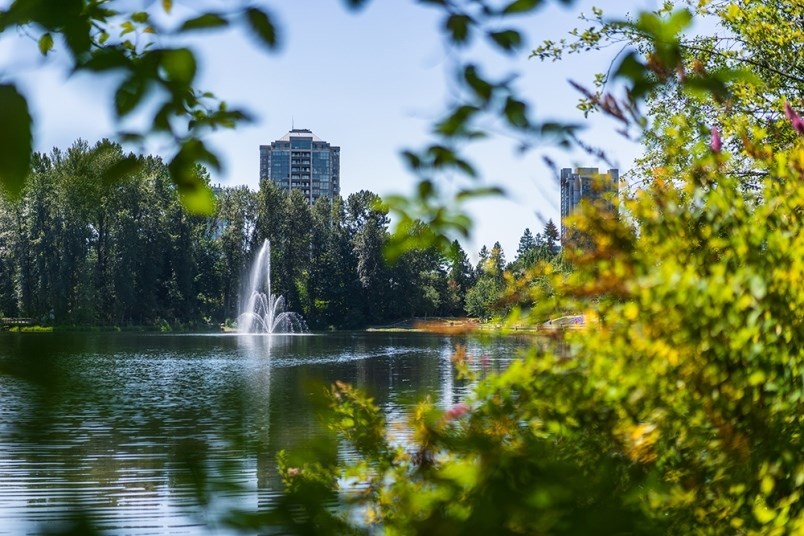 Lafarge Lake loop is part of the Great Trail of Canada, according to Trails BCPHOTO: CITY OF COQUITLAM
Lafarge Lake loop is part of the Great Trail of Canada, according to Trails BCPHOTO: CITY OF COQUITLAMIt starts by taking in the old town of Port Moody, continues via the Rocky Point Park and Shoreline Park trail system, travels to Coquitlam’s town centre along Guildford Way, passes through Hoy Creek Trail, a connector greenway between Douglas College Campus and Coquitlam Centre Park.
Highlights include spectacular coastal views, as well as a major fish hatchery on Hyde Creek in Port Coquitlam. The trail includes part of the Port Coquitlam Traboulay PoCo trail that encircles Port Coquitlam, too.
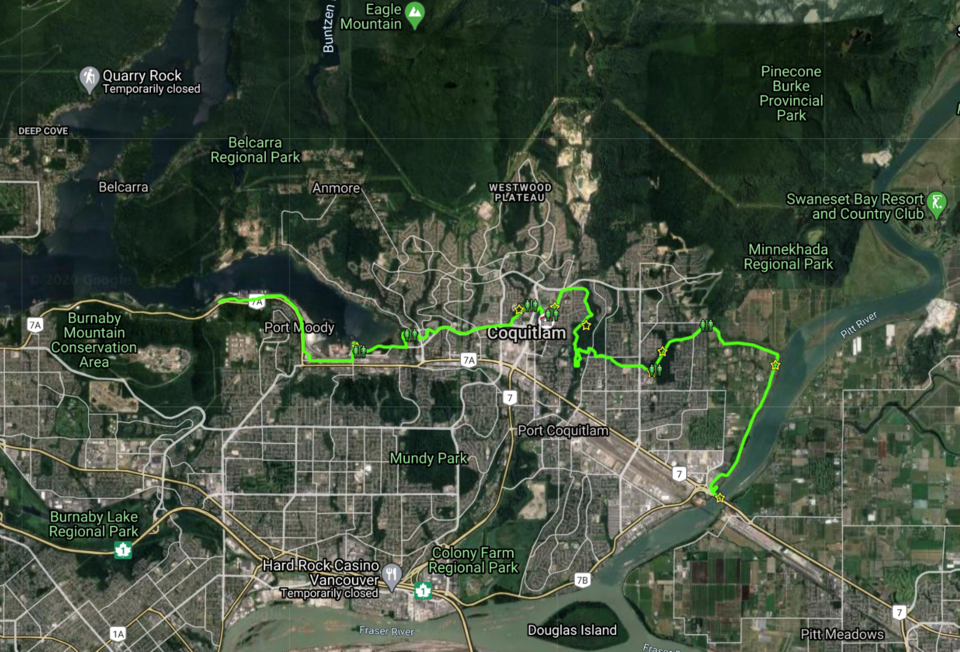 Screenshot / Google Maps via Trails BC
Screenshot / Google Maps via Trails BCPitt Meadows and Langley
This more rural section of the Great Trail traverses 37km from the Pitt River Bridge to Abbotsford, in addition to 46km of optional trail spurs in Maple Ridge.
From the Pitt River Bridge, the main route heads towards the Golden Ears Bridge via the Pitt River Regional Greenway, offering breathtaking views of the Golden Ears in the Alouette Provincial Park, cranberry and blueberry fields, and log booms in two different rivers.
Highlights along this section of trail include the Fort Langley National Historic Site, as well as bucolic farmland, non-motorized dike trails - and even equestrian options for those who’d prefer to travel the trails by horseback.
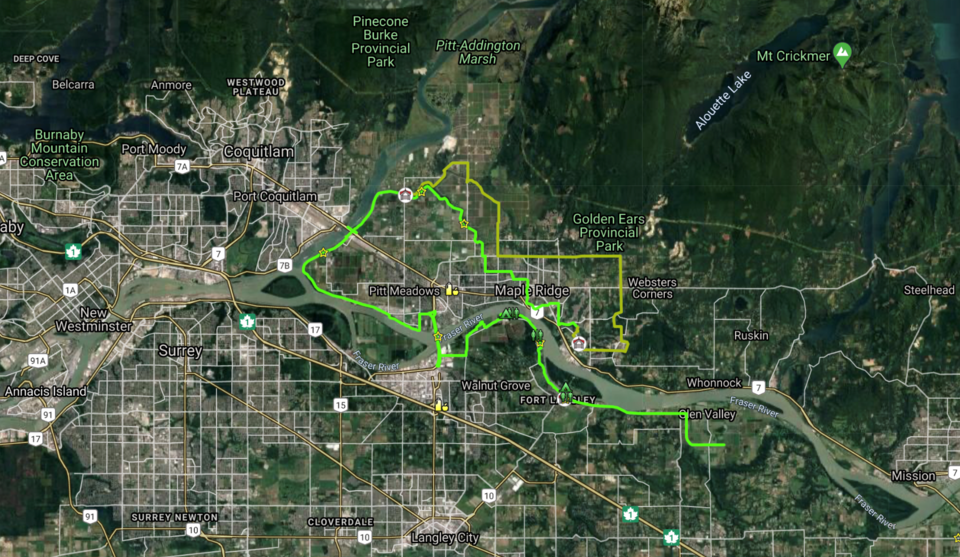 Screenshot / Google Maps via Trails BC
Screenshot / Google Maps via Trails BC
From Vancouver, trail users can also opt to head to the coast via Tsawwassen, from which point they can head east towards Langley.
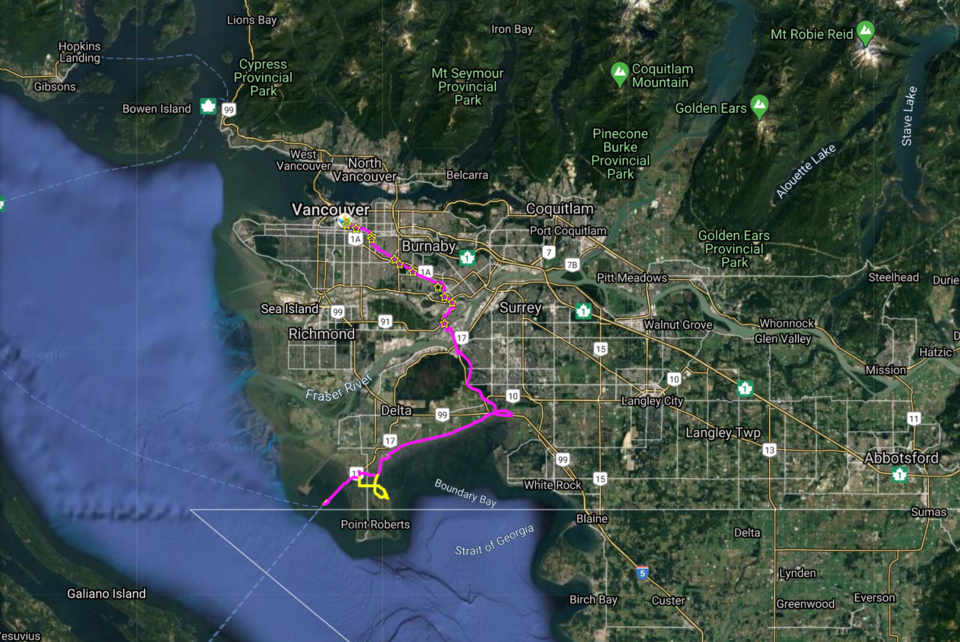 Screenshot / Google Maps via Trails BC
Screenshot / Google Maps via Trails BC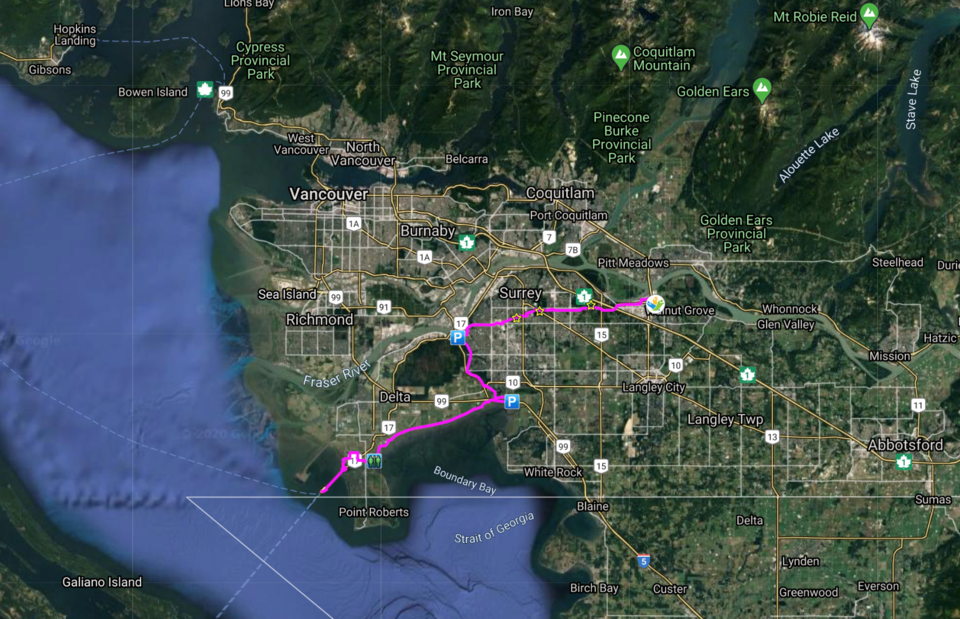 Screenshot / Google Maps via Trails BC
Screenshot / Google Maps via Trails BCNearby routes
For Vancouverites wanting to get out of their neighbourhoods now that Dr. Bonnie Henry has given the OK for regional travel this summer, there are several more sections of the Great Trail that traverse other areas of B.C.
Hop aboard a ferry to experience the westernmost portion of the Trans Canada Trail on Vancouver Island. Beginning in Victoria, this section takes trail users along a 200-km route from the capital of British Columbia to Nanaimo. There, the trail connects to the mainland by ferry at Departure Bay.
From there, mountain lovers can opt to head north and follow the 70-km Sea to Sky trail from Squamish, through Whistler, all the way up to Pemberton. Along the way, walkers and cyclists can expect to see rushing glacier-fed rivers, stunning waterfalls and, of course, breathtaking views of the snowy alpine.
For those who’d rather follow the majority of the route through the Lower Mainland and Vancouver, the Great Trail continues on from Abbotsford through the Fraser Valley, covering hundreds of kilometres of scenic trails before meandering its way into B.C.’s interior.
Trail use in the age of COVID-19
Access to the Great Trail system is increasingly important to Canadians, the Leger poll suggests, with youth and young adults the biggest group of trail users.
Millennials and Gen Z are the largest demographic of trail users with 88% of Canadians aged 18-34 using trails, compared to 78% for those aged 35-54 and 63% of Canadians aged 55 and over, according to the new survey commissioned by Trans Canada Trail (TCT).
The online survey, conducted June 5 to June 7, also shows that many Canadians have continued to turn to trails during the COVID-19 pandemic, with 78% feeling trails are safe to use for leisure activities. However, 60% of trail users say they want clearer information on the trail itself, 59% want clearer information online about trail usage, and 57% want guides on how to use trails in safer ways.
To that end, TCT has released “National Trail Guidelines: Responsible Trail Operations and Visitation during the COVID-19 Pandemic”, based on global best practices and public health advice.
“Canadians’ nationwide love of trails emphasizes the importance of trails in combatting social isolation,” noted Eleanor McMahon, president and CEO of Trans Canada Trail, in a press release.
-
With files from Diane Strandberg / Tri-City News
